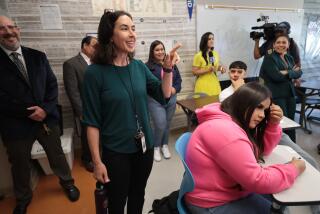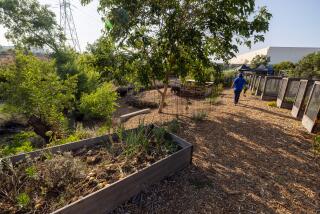Lassen--A Year-Round Success Story : Elementary School Provides Lessons for Parents and Teachers
- Share via
A few years ago, when Barbara Reichenbach’s family moved to Sepulveda, neighbors filled her in on the local supermarkets, the dry cleaners and what to expect when she enrolled her daughter at the nearby public school.
“When I heard that Lassen Elementary School was on a year-round schedule, I had a very negative feeling about it,” recalled Reichenbach. “But the teachers and the staff sold me on the system, and now I love it.”
Reichenbach said she found the schedule of nine weeks of school followed by three weeks off “a lot easier” for both children and teachers.
“What the school district really needs to do is find a new title for year-round because people don’t understand the concept,” she added. “The children are not going to school the entire year. They have vacations. The title ‘year-round’ is misleading.”
In 1974, Lassen became one of the first Los Angeles district schools to adopt a year-round calendar. Because parents and teachers have had more than a decade of experience with the program, Reichenbach and other Lassen parents are frequently called upon to talk about their experiences.
Increased Interest
Interest in year-round schools has increased dramatically this fall because the Los Angeles Unified School District board is considering proposals to relieve the overcrowded conditions that exist at some schools by placing the entire district on a year-round calendar.
The district proposes to divide the student body at each of its 618 schools into several groups. These groups would attend school at different times throughout the year. At any time of the year, at least 125,000 of the district’s 572,000 students would be on vacation, thus allowing the district to increase its capacity without building new schools.
Two versions of a year-round calendar are under consideration. One is a five-term school year in which students would attend four 45-day quarters and have a 45-day vacation. Students would also have a three-week summer vacation and a two-week winter break.
The other proposed calendar is a four-term school year in which students would attend three 60-day quarters and have one 60-day vacation. This plan also calls for an eight-day winter vacation and a three-day summer break.
Many San Fernando Valley parents of elementary school children have expressed displeasure at the prospect of students attending classes during hot summer months, especially at schools that are not air-conditioned.
They have also questioned whether a year-round calendar has any educational benefits and how families would cope with children who have vacations at different times of the year. Valley parents have also expressed fears that youngsters who attend school in the summer will not be able to participate in traditional summer activities, such as camping.
Some of the answers to these questions can be found in the experiences of parents and teachers at Lassen.
The school voluntarily adopted a year-round calendar because parents believed it would improve the quality of education. The school is run on the so-called single track, 45/15 calendar, which is not among the options being considered by the school board if all schools go year-round. Under 45/15, the year is divided into four nine-week terms--each with 45 school days--that are separated by four three-week vacations. Because all students are on the same single-track schedule, the entire school is on vacation when the break of 15 school days arrives.
During the 15-day vacation period, students can return to campus for “intersession” courses. These classes can be enrichment or remedial courses, depending on the needs of the individual students. Intersession classes, combined with before- and after-school care provided for a fee by the YMCA, allow children to remain on Lassen’s campus when their vacations do not coincide with their parents’ vacation.
School Not Overcrowded
Lassen’s decision to go on a year-round calendar was based solely on the notion that it would provide a better educational environment. Indeed, Lassen is far from overcrowded; there are empty classrooms at the school. In any case, according to the National Council on Year-Round Education, the 45/15 plan is not designed to save space but to break up the long summer vacation in an attempt to eliminate the “learning loss” many teachers say occurs during long vacations.
“On a traditional calendar, you spend September reviewing,” said Pat Gennaro, who teaches a combined class of fourth- and fifth-graders at Lassen. “But we’ve just returned from a three-week break and we didn’t take any time to review. We just dug right in on what we were doing before we went on break.”
Teachers add that students seem to be better-behaved after a short break than are students who return to school after a three-month vacation.
“We have better control and discipline because the kids aren’t away from us long enough to get rambunctious,” said Lassen Principal Suzanne Hoffman.
“When they come back they still remember the rules. They still remember how to be students,” added Reva Sander, a third-grade teacher who has taught at Lassen for 11 years.
No Difference in Scores
While Lassen students seem to retain more and show better conduct after vacation breaks, their scores on standardized tests for the past three years were neither better nor worse than the scores of students at nearby elementary schools that are on the traditional two-semester calendar.
This lack of a clear difference between the achievement of students at year-round schools and those at traditional schools is supported by a report prepared in 1978 by SRI International, a Menlo Park research firm.
“Students in the year-round school program did not suffer a loss in achievement from spring, 1977, to fall, 1977, but--contrary to expectation--neither did students in the traditional calendar school program,” the report stated. “We concluded that there was no difference in the size of achievement gains between students in the year-round school program and the traditional calendar school program.”
Since Lassen is not air-conditioned, Hoffman and her faculty agreed that one problem with a year-round schedule is teaching on hot summer days. Last summer, the district provided portable fans for most classrooms and offices. The district also allows year-round schools the flexibility to end the school day early during the summer.
Beating the Heat
But the Lassen staff has come up with its own ways to beat the heat. School started earlier--8 a.m. instead of 8:20 a.m.--and lunch was shortened to 30 minutes from 45 minutes so that students could be released earlier, before the day became too hot.
Also, every Lassen teacher has his or her own technique for keeping cool. Eve Marsh, for instance, holds P. E. classes inside and allows her fifth- and sixth-graders “more time to relax and more drinks of water.”
Said Hoffman: “We relax things around here. If the kids are sitting under the trees during recess, I’m not going to force them out on the playground. We sell ice cream for fund-raisers and do things like that.”
Parents of Lassen students add that school during the summer doesn’t create too many problems.
“There is very little keeping the children home because of the heat. It’s not like parents who keep their kids home because of the rain,” said Reichenbach.
“On hot days, the kids come home from school, have a snack, swim all afternoon and then do homework,” added Ann Titsworth, who has a child attending Lassen.
Lassen parents also say that having children on a year-round schedule while their siblings attend traditional calendar schools isn’t a problem. In fact, some parent enjoy the split schedules.
“I get to spend individual time with each of my sons,” said Arlene Maeda. “Sometimes you don’t get to do that when you have more than one child. Sometimes the middle children get lost in the shuffle.”
Outside Activities Continue
Parents also said there are few problems with the children participating in extracurricular activities that take place during the summer.
“I’m a Girl Scout leader and my daughters are involved in troops where they are combined with girls from other schools,” said Titsworth. “Sometimes my girls are fortunate to be off from school when the scouts have evening activities. That way they don’t have to worry about going to school the next day.”
She added that Lassen children have three weeks off in August, so they have the chance to go to camp and take part in those kinds of activities.
“The one thing we do miss out on are many of the city park programs,” Titsworth said. “Maybe if the entire district goes on year-round, the city might have to look (at changing) their programs.”
Reichenbach said that children who play Little League have an advantage over children who attend regularly scheduled schools because they have a three-week break during early spring practices.
Time for Batting Practice
“It’s nice that they don’t have to do homework when they are so tired from practice,” Reichenbach said. She said her son also has more time to go to the batting cage. “I can’t think of one activity that my sons have had to miss because of year-round (schools),” she said.
Last summer, representatives from Lassen met with the school board’s Building Committee to discuss the possibility of air-conditioning the school. Because Lassen converted to a year-round calendar voluntarily, committee members said the school was low on the priority list. Schools that were forced to accept a year-round plan were being given a higher priority.
“One of the committee members said that if we didn’t like teaching during the summer months, maybe we should go back to a traditional calendar,” Hoffman said. “We answered ‘no way.’ We like this calendar and want to stay with it--air-conditioning or no air-conditioning.”
More to Read
Sign up for Essential California
The most important California stories and recommendations in your inbox every morning.
You may occasionally receive promotional content from the Los Angeles Times.













